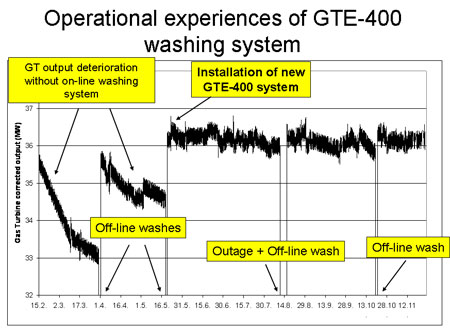Pumps & Systems, December 2008
As the need to increase efficiency and meet lower emissions requirements puts pressure on gas turbine operators, they look for innovative solutions that do not necessitate large capital costs or high risks to make improvements. Some of the more reliable enhancements are water injection for nitrogen oxides (NOx) reduction, online and offline water wash programs to maintain compressor efficiency and fogging for power augmentation.
Water Injection
In water injection, which is used to reduce NOx emissions in the turbine exhaust, the water is scheduled based on total fuel flow, ambient temperature and relative humidity. The pumping skid, which provides the scheduled flow, can be complex and inefficient. Currently, auxiliary systems all employ dynamic pumps with efficiency ratings of 60 percent or less (such as centrifugal or multistage centrifugal pumps) or positive displacement "plunger style" pumps with high maintenance intervals.
Operators can improve flow accuracies and reduce power consumption by examining and/or replacing the motor-pump set. For instance, improvements to axial piston, positive displacement pumps have made them viable for the power market. These PD pumps are 97 percent efficient, which correlates to a reduction of required horsepower to greater than 50 percent in some cases. These pumps are made of 316SS (body, flange, shaft and internals) and have maintenance intervals at every 8,000 operating hours. Additionally, they do not require doping of the de-mineralized water supply or speed reduction devices such as pulleys, and belts or gearboxes, which create compact footprints.
A nine-piston pump design reduces pulsations associated with plunger pumps and allows skid designers to remove pulsation dampeners. Because these pumps are directly coupled to the motor, they can also be driven by variable frequency drives for accurate flow control, which is generally required for spray optimization.
A new water injection installation usually requires the gas turbine manufacturer, but reputable third party OEMs can design, build and install these improved pumping systems to meet local and federal environmental regulations.
Water Wash Systems
For gas turbine performance gains of 2 to 4 percent, a water wash skid/system can be installed and an off-line/on-line maintenance schedule created. According to Tom Wagner, technical director with GTE, a highly atomized water wash unit is the most effective way to maintain gas turbine output (see Figure 1) [1].
 Recent improvements have made water wash systems effective in preventing performance degradation from compressor blade fouling. Fouling occurs when airborne contaminates are ingested in the inlet of the gas turbine and "stick" to the compressor blades. The build-up of these particles gradually reduces efficiency and increases operational cost.
Recent improvements have made water wash systems effective in preventing performance degradation from compressor blade fouling. Fouling occurs when airborne contaminates are ingested in the inlet of the gas turbine and "stick" to the compressor blades. The build-up of these particles gradually reduces efficiency and increases operational cost.
Updated water wash pumping systems use a VFD to accurately control high pressure water flow, created via a premium efficiency motor directly coupled with the PD pump(s) described above. The downstream nozzles are designed to take this pressure and flow parameters to create optimal droplets which will clean the blades, but will not cause erosion during on-line washes. The necessary droplet size has been established to be approximately 80-120 microns, but each gas turbine is unique and droplet optimization should be determined by the OEM or a reputable third party.
Water injection, water wash and fogging (see below) all require accurate droplet definition and volume limitations/ratios to achieve the best results. Increasingly, OEMs are relying on CFD analysis and laser measurements to design nozzles that better control droplet size, droplet momentum and spray pattern based on these new pump capabilities.
Inlet Fogging and Wet Compression
Two controversial, but highly effective means of power augmentation are inlet fogging and wet compression. Although they are similar, fogging is used to cool inlet air by spraying precisely controlled droplets in the inlet. Evaporation occurs prior to blade contact, which increases mass air flow into the compressor and power output. This technology yields gains as high as 11 percent, depending on ambient conditions such as temperature and relative humidity, but the typical average is 6 percent. The installed cost is low and the return on investment can be 18 months or less.
Wet compression, or high fogging, is a patented approach that allows >20 micron water droplets to penetrate the compressor. According to Don Fraser with Siemens Power Generation, this technology has been safely applied to legacy machines. Don Shepherd with Caldwell Energy reports that the increased capacity can be as high as 15 to 25 percent [2].
Conclusion
The heart of these systems is the highly efficient, VFD driven motor pump set and precisely designed nozzles unique to each application. Typically, these ancillary systems can be installed during a short outage, and each has a quick payback.
References
-
Thomas Wagner and Robert Burke, ASME Presentation, July 22, 2008. Gas Turbine Efficiency.


